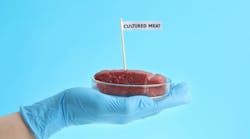When we last devoted a feature to cultured meat in November 2019, the general tone of that story was that the technology was fascinating, fast-moving and likely to become reality in several years. Just 18 months later, cultured chicken is being sold in "1880," a Singapore restaurant.
Admittedly, it's only one restaurant and it's in Singapore, plus the price is several times the price of chicken. Additionally, this particular product, from U.S. firm Eat Just, is 70% lab-grown meat with the remainder being plant-based proteins (especially mung bean) that are typical ingredients in meat analogues. But cultured meat has arrived there, and it's likely to pop up in more places – like Israel – before arriving in the U.S. … maybe in a few years.
Call it cultured, cell-based, cultivated or lab-grown meat. Some of the companies involved in this technology—and there are at least two dozen of them—like the term "clean meat." The FDA and USDA have referred to it as "animal cell culture technology" – and those two U.S. agencies will jointly oversee its regulation.
By any name, it's quickly moving from the lab to the factory, from prototype portions that cost thousands of dollars to make to products that are coming close to competing with the prices of slaughtered animals. Although not quite yet.
For all the hype and hoopla over plant-based meat analogues, most true carnivores can tell the difference. The success of those products seems to depend on consumers recognizing the difference but choosing a slightly inferior product for a myriad of laudable reasons. Those products, too, have made great strides in recent years and likely will continue to do so; but some of those improvements have resulted in sketchy ingredients and lengthy ingredient statements.
Why look for alternatives to animal meat? Most consumers still don't care, but an increasing number do recognize it as an anachronism: an ancient, inhumane, terribly inefficient, unsustainable and polluting system that one day is likely to be unable to meet rising demand, here in the U.S. and across the globe.
Global production of meat doubled in the 30 years from 1988 to 2018 and increased four-fold since the mid-1960s, according to The World Counts (www.theworldcounts.com). Production is expected to be 460-570 million tons by 2050; at the high end, that would be double what it was in 2008.
That's not an opportunity, that's a problem. Meat is a very inefficient food source, requiring more energy, water and land to produce than any other food source – meaning that it could crowd out farmed crops. Some doubt the global meat industry has the capacity to meet that demand. Meat production also is a major source of greenhouse gas emissions and thereby plays a role in climate change.
"If everyone shared the meat-heavy diet of the average American [273 lbs. a year], the world could feed just 2.5 billion people," says The World Counts. World population currently is at 7.9 billion and projected to hit 10 billion in 2045.
"Slaughtering" an animal also creates the possibility of introducing dangerous, even fatal, diseases and microorganisms into the meat. In the past, that meant E. coli, salmonella and the like, but now the term "zoonotic disease" is being added, and that includes coronavirus.
Ergo, cultured meat is the solution to all the world's problems … according to the technology developers.
Cultured Meat Suppliers
These are the suppliers of cultured meats (and seafood) that responded to our call for information:
Aleph Farms, Rehovot, Israel
Meat: Beef steak
Investors: VisVires New Protein, Strauss Group, Cargill, M-Industry (Migros Group)
When: A thin-cut beef steak in 2022
BlueNalu, San Diego
Meat: Seafood, currently finfish (mahi mahi, bluefin tuna, red snapper) with plans to add crustaceans and mollusks
Investors: Griffith Foods Worldwide, Nutreco Investments BV, Pulmuone USA, Rich Products Corp., Sumitomo Corp. of Americas (Presidio Ventures), Thai Union
When: First half of 2022
Eat Just, San Francisco
Meat: Chicken, beef on the way
Investors: Temasek, Mitsui, Founders Fund, Li Ka-shing, Khosla Ventures, Heineken Family, Jerry Yang, Marc Benioff, Qatar Investment Authority, Charlesbank Capital Partners, Vulcan Capital (the investment arm of the estate of Microsoft co-founder Paul G. Allen)
When: Already supplying a restaurant in Singapore
Matrix Meats, Dublin, Ohio
Meat: "Any type of meat or fat, we are even experimenting with insects and milk"
Investors: Unovis Asset Management, CPT Capital, Siddhi Capital, Clear Current Capital, Ikove Startup Nursery Fund
When: (Not saying)
Meatable, Delft, The Netherlands
Meat: Pork and beef
Investors: Dr. Rick Klausner (former director of the US National Cancer Institute and former Executive Director of Global Health at the Bill & Melinda Gates Foundation), Section 32 (Ex-Google Ventures-CEO Bill Marris), Dr. Jeffrey Leiden, DSM Venturing, BlueYard Capital, Agronomics, Humboldt, Taavet Hinrikus
When: By 2025
Memphis Meats, Berkeley, Calif.
Meat: Beef, chicken and duck
Investors: SoftBank, Norwest, Temasek, Richard Branson, Bill Gates, Threshold Ventures, Cargill, Tyson Foods, Kimbal Musk
When: (no answer)
Mosa Meat; Maastricht, Netherlands
Meat: Beef
Investors: Nutreco, Jitse Groen, Blue Horizon Ventures, M Ventures, Bell Food Group, Mitsubishi Corp.
When: "In the next few years"
Shiok Meats, Singapore
Meats: Seafood/crustaceans
Investors: Monde Nissin and a handful of European and Asian investment funds
When: 2022
SuperMeat; Tel Aviv, Israel
Meats: Chicken
Investors: (no answer)
When: 2022
Everybody's doin' it
A 2016 report from IDTechEx listed the cultured meat "industry" that year as consisting of Memphis Meats, Modern Meadow, Mosa Meat and SuperMeat. While Modern Meadow has fallen by the wayside, the other three are joined in the current list by Aleph Farms, Appleton Meats, Avant, Balletic Foods, Biftek.co, Biofood, BioTech Foods, BlueNalu, Clear Meat, Cubiq, Eat Just/Good Meat, FM, Fork & Goode, Future Fields, Higher Steaks, IntegriCulture, Meatable, Mission, New Age Meats, SeaFuture, Shiok Meats, Supreme, Wild Type. That's 26, and we probably missed a few.
And it's no longer cow-beef they want to replace. Some of the above companies are working on chicken, duck, pork, seafood, even milk replicants.
"When Memphis Meats was founded in 2015, there were no other cell-cultured meat companies in the world," that company's spokesperson told us. "Today, there are dozens of companies spanning every continent but Antarctica."
Although we must qualify that statement. Maybe it wasn't a formal company yet, but Mosa Meat, based in Maastrict, Netherlands, claims to have first cultivated a beef burger from cells in 2013 at a cost of $280,000 per burger, according to one of our earlier stories.
Comparing costs, another European firm in this space, Biotech Foods in San Sebastián, Spain, a year ago reported it can produce a kilogram of cultured meat from cells at a cost of about 100 euros (approximately $112). Aleph Farms in 2018 reported one serving (they didn't specify the size) of steak cost $50 to produce; and with the April 2020 completion of its first pilot BioFarm, that price is tumbling.
"As Aleph scales its BioFarms, the cost per steak will reach parity with slaughter-based meat within a few years," says a spokesperson.
Aleph Farms plans to launch its first consumer product, a thin-cut beef steak, in 2022, first in foodservice and then in retail.
This early in the game, it's hard to name a front-runner. Eat Just, as we said, is the creator of the chicken portions in that Singapore restaurant – but they're small chicken chunks in multi-component dishes: Chicken & Rice, Katsu Chicken Curry and Chicken Caesar Salad. In our January issue, we had a photo of Israeli Prime Minister Benjamin Netanyahu tasting a whole-muscle steak from Aleph Farms.
Cultured meat has become an international phenomenon, with groundbreaking university research coming out of Netherlands and Israel. Israel, notably, is home to four of the companies: Aleph Farms, Future Meat Technologies, MeatTech and SuperMeat.
Other populous countries with high-income carnivores and little land and domestic meat production see it as a way to become less reliant on imported meats. For those reasons, Japan also is rabidly interested.
Late last year, the Singapore Food Agency (SFA) said an expert working group reviewed data on Eat Just’s cultured chicken. “It was found to be safe for consumption at the intended levels of use, and was allowed to be sold in Singapore as an ingredient in Eat Just’s nuggets product,” the SFA said in December.
How it's (well) done
A late-2019 Bloomberg story summarized Eat Just's process of taking extracted animal cells and turning them into chicken nuggets: "Technicians grow the cells (the company’s catalog includes both stem cells and not) in baths of nutrient-rich liquid media, a bespoke 'feed' that includes salts, sugars, amino acids."
The writer concluded: "The texture still needs work—it’s a bit too smooth and not quite fibrous enough, closer to Play-Doh or a firm tofu. It’s not sufficient to simply culture muscle fibers to get a better mouthfeel. You need the structure of other cells, such as fat and blood vessels, all aligned in a matrix of the right density; it’s a huge challenge. It’s a feat of science that such a food can be made at all."
But that was 2019, and Eat Just said it's improved its product since then.
What makes cultured meat so expensive is not the starter meat cells. "The most expensive inputs in the process are the non-animal proteins incorporated in the growth medium used to feed the cells," explains Didier Toubia, co-founder and CEO of Aleph Farms. "Today, they are produced in small quantities (if at all) and (are) pharmaceutical grade, thus, expensive.
"We need infinitesimal small quantities of those proteins in our growth medium," he continues. "Other similar proteins are today produced at $10/kg for food (enzymes, rennet for cheese production) or consumer applications, so the potential cost reduction is validated."
A spokesperson for Mosa Meat concurs. "We've overcome some major scientific hurdles, such as eliminating the use of foetal bovine serum in our production process and reducing the cost of our medium by 88 times. We also have a dedicated automation team working on scaling up our production and sometimes building new machines from scratch."
Most of the companies are succeeding in creating small chunks of cultured meat or seafood. But whole-muscle products are something of a holy grail. Aleph Farms' focus is on structured meat products, steaks.
"For us, it’s not enough to just make a protein that fills a nutritional gap, so we bypassed the easier step of developing hamburger or meatball products and focused on steaks," says Toubia. "We believe we need to capture the full quality experience of meat in order to drive the largest impact.
Growing Milk, Not Meat
Perfect Day Foods (perfectdayfoods.com) claims to have made "the world’s first real milk proteins made without animals."
The company inserts milk protein genes into the DNA of microflora—in their case, fungi—which then convert plant sugar into whey and casein, milk’s main proteins. Once separated from the fungi and remaining sugars, the proteins are dried into a powder.
Later on, this protein powder is mixed with water, vitamins, minerals and plant-based fats and sugars using the nutrient proportions in cow’s milk.
"Quality meat has desirable muscle and fat composition, texture and form. Within a cultivator, structures—called scaffolding—provide a surface for the cells to mature into muscle and fat, and into the desired texture and form. In meat cultivation, scaffolding is used to mirror the natural cellular environment, called the ‘extracellular matrix.’ The extracellular matrix is an interlocking matrix of fibrous proteins that are necessary for cell function."
Smaller, less complex scaffolding is effective for cultivating ground meat, such as meat used for burgers, sausages and nuggets, Toubia continues. "More complex scaffolding is needed for cultivating meat with a specific structure and thickness, like steak. Scaffolding with a porous structure allows nutrients to reach the cells inside thicker cuts of meat."
Another Israeli company, Meat-Tech 3D is developing cultured meat products using proprietary 3D bioprinting technology. The company already is listed on the Tel Aviv stock exchange and this February filed to raise up to $29 million in an initial public offering in the U.S.
There's been no shortage of money thrown at these upstarts by high-profile investors, including a handful of animal meat companies, such as Cargill, Tyson and Thai Union (see profiles). In almost all cases, these investors have also bought stakes in plant protein companies, so they're hedging their bets, wanting to continue as the providers of protein no matter what the source in the future.
And consumers? Most remain in the dark about cultured meat, although probably not for much longer. Eat Just shared with us preliminary results of a survey of U.S. and Singapore consumers taken by "a leading management consulting firm." It found:
- 72% of U.S. chicken consumers and 83% of Singapore chicken consumers said they would consider purchasing
- 69% of U.S. consumers and 75% of Singapore consumers expressed a willingness to substitute conventional chicken with cultured meat
- 91% of restaurant operators polled were open to selling cultured meat.
So enjoy (or not) that Impossible Whopper while you can. Cultured meat is coming soon.


